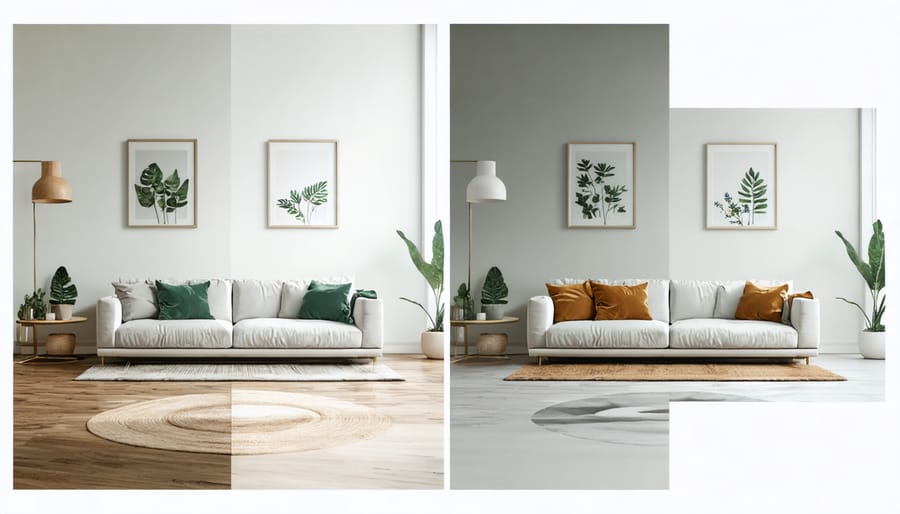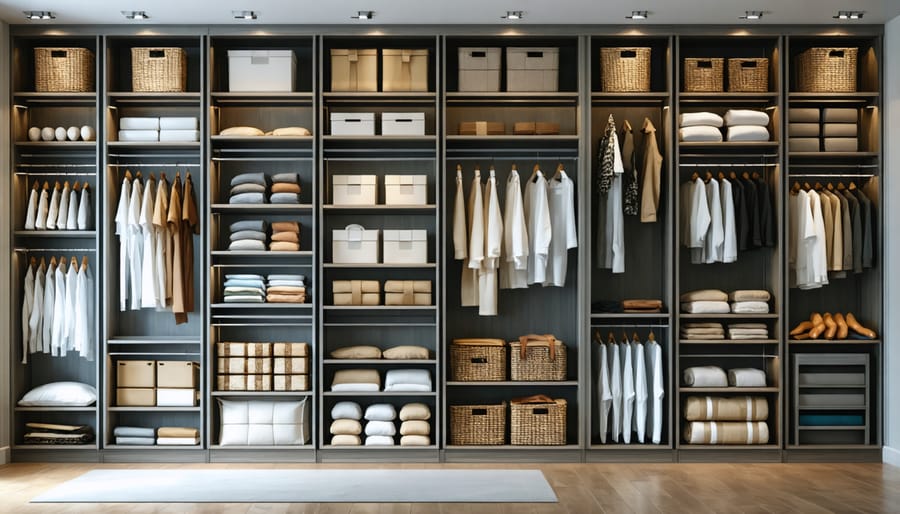Transform your home effortlessly through the seasons by layering versatile, neutral foundation pieces with seasonal accent colors. Start with a timeless base palette of whites, grays, or warm beiges, then introduce nature-inspired elements that reflect each season’s distinct character. Think cozy autumn throws in rust and amber, fresh spring botanicals in sage and blush, crisp summer linens in seafoam and coral, or plush winter textiles in deep blues and forest greens.
The secret to seamless seasonal transitions lies in smart investment pieces that adapt year-round. Choose furniture with clean lines and neutral upholstery, then rotate smaller decor elements like pillows, artwork, and table accessories to reflect the changing seasons. These thoughtful adjustments create dramatic impact without overwhelming renovation costs or storage challenges.
Master the art of seasonal layering by focusing on texture and pattern rather than complete room overhauls. Switch out lightweight curtains for heavier drapes, replace woven baskets with metallic accents, or update botanical arrangements to mirror nature’s rhythm. This approach maintains your home’s core aesthetic while celebrating each season’s unique energy through strategic, manageable changes that feel both fresh and familiar.
Creating Your Seasonal Color Foundation

Choosing Neutral Anchors
When creating a year-round design foundation, selecting neutral anchors is crucial for seamless seasonal transitions. These versatile colors serve as your canvas, allowing you to experiment with different seasonal accents while maintaining a cohesive look. While understanding color wheel principles is important, choosing the right neutrals requires special consideration.
Start with warm greys, soft taupes, and creamy whites for larger elements like walls, sofas, and area rugs. These shades work beautifully across seasons and provide a sophisticated backdrop for any color palette. Consider greige (a blend of grey and beige) for its exceptional versatility and modern appeal.
When selecting neutral pieces, pay attention to undertones. Cool neutrals with blue or green undertones pair well with winter and summer decor, while warm neutrals with yellow or pink undertones complement fall and spring aesthetics. For maximum flexibility, choose pieces in multiple neutral shades that work together harmoniously.
Natural materials like jute, wood, and stone often feature inherent neutral colors that add texture and depth to your space. These elements create visual interest while maintaining the neutral foundation you need for easy seasonal updates.
Remember to vary the textures within your neutral palette to prevent the space from feeling flat. Mix smooth and rough surfaces, matte and glossy finishes to create dimension that enhances your seasonal decorating efforts.
Seasonal Accent Planning
Planning seasonal color accents is like creating a versatile wardrobe for your home, allowing you to refresh your space effortlessly throughout the year. Start by selecting a neutral base palette for your main furniture and permanent fixtures – think whites, grays, or warm beiges. This creates the perfect canvas for rotating seasonal elements.
For each season, choose 2-3 complementary accent colors that reflect the natural world. Spring might feature soft pastels like blush pink and mint green, while summer could embrace vibrant yellows and ocean blues. Autumn calls for warm oranges and deep reds, and winter can showcase rich jewel tones or crisp arctic whites.
Create a storage system for your seasonal items, using clear bins labeled by season or color scheme. Focus on easily changeable elements like throw pillows, blankets, artwork, and small decorative pieces. These items should be relatively inexpensive and easy to store when not in use.
Pro tip: Invest in versatile pieces that can work across multiple seasons by simply changing their styling. A glass vase, for example, can hold spring tulips, summer sunflowers, autumn branches, or winter pine cones. Consider creating a seasonal rotation schedule, perhaps aligned with major holidays or the equinoxes, to make your transitions feel natural and purposeful.
Remember to take photos of your successful seasonal arrangements – they’ll serve as helpful references for next year’s transitions and inspire new combinations.

Effortless Season-to-Season Transitions
Spring to Summer
As the last frost melts away and temperatures begin to rise, transitioning your home’s color palette from spring to summer offers an exciting opportunity to refresh your living space. Start by gradually introducing vibrant summer hues alongside your existing spring pastels. Replace light mint greens with deeper emerald tones, and swap out soft lavenders for bold purples or striking fuchsias.
Layer in summer colors through easily changeable elements like throw pillows, lightweight curtains, and decorative vases. Natural materials like woven baskets and driftwood pieces can help bridge the seasonal gap while adding texture. Consider incorporating tropical leaf patterns or botanical prints to capture summer’s energetic spirit.
Don’t feel pressured to remove all spring elements at once. Keep some pastel accessories as neutral anchors while introducing brighter accents. Fresh flowers are perfect transitional pieces – start with spring blooms and gradually shift to summer varieties like sunflowers and dahlias. Update your tablescapes with citrus colors and natural elements like seashells or river stones.
Remember to maintain balance by distributing bold summer colors throughout your space rather than concentrating them in one area. This creates a harmonious flow that makes the seasonal transition feel natural and intentional.
Summer to Fall
As summer’s vibrant hues begin to fade, transitioning your home to fall’s warm embrace doesn’t have to be complicated. Start by gradually replacing bright summer accessories with deeper, earthier tones. Swap out turquoise and coral throw pillows for rich burgundy, amber, and forest green options. Layer your existing neutral furniture with cozy throws in rust and golden brown shades.
Natural elements play a crucial role in this seasonal shift. Replace summery flowers with dried wheat stalks, pine cones, and branches with turning leaves. Consider introducing copper or bronze accents through picture frames and decorative bowls to enhance the autumn atmosphere. Area rugs in warm patterns can easily transform your space while providing additional comfort as temperatures drop.
Lighting also plays a key role – switch out bright white bulbs for warm-toned options to create a cozy ambiance. Add amber-colored glass votives and lanterns to create intimate corners perfect for fall evenings. Remember, you don’t need to change everything at once; gradual transitions often feel more natural and are easier on your budget.
Fall to Winter
As the vibrant autumn leaves give way to winter’s first frost, your home’s aesthetic can follow nature’s lead with graceful transitions. Replace warm oranges and deep reds with cooler tones like ice blue, silver, and crisp white. Start by swapping out throw pillows and blankets, opting for chunky knits and plush textures that help create a cozy atmosphere during the colder months.
Layer your lighting with soft white bulbs and strategically placed candles to combat the earlier sunsets. Consider introducing metallic accents through picture frames, vases, or decorative objects to reflect light and add winter sparkle. Replace autumn-themed centerpieces with winter elements like pinecones, bare branches, or mercury glass ornaments.
Don’t forget your textiles – switch lightweight curtains for heavier fabrics, and add area rugs to bare floors for both warmth and style. Move furniture slightly closer together to create intimate conversation areas, perfect for those long winter evenings. Remember, the key is to make these changes gradually, allowing your space to evolve naturally with the season.
Winter to Spring
As winter’s cozy layers give way to spring’s fresh energy, transitioning your home decor doesn’t have to be overwhelming. Start by gradually replacing heavy textiles with lighter alternatives – swap out thick wool throws for cotton blankets and exchange velvet pillowcases for linen ones. Clear away winter’s darker accessories, making room for brighter elements that mirror nature’s awakening.
Incorporate fresh greenery through potted plants or botanical prints, instantly breathing life into your spaces. Consider updating your color palette by introducing soft pastels and nature-inspired hues through small accents like vases, artwork, or decorative bowls. For more inspiration, explore our comprehensive spring decorating ideas guide.
Don’t forget to refresh your window treatments – replacing heavy drapes with sheer curtains allows more natural light to flood your rooms. Finally, deep clean your space and reorganize storage solutions to embrace the season’s minimalist energy. This thoughtful transition helps create a harmonious flow between seasons while maintaining your home’s comfort and style.
Budget-Friendly Transition Techniques
Smart Accessory Choices
Accessories are your secret weapon for seamless seasonal transitions, offering a budget-friendly way to refresh your space without major commitments. Start with throw pillows in seasonal colors – swap cool blues and greens of summer for warm oranges and deep reds in fall. Layer different textures and patterns while maintaining your core color scheme as a foundation.
Consider rotating artwork as the seasons change. Simply switching out prints or photographs can dramatically shift your room’s mood. For instance, replace bright coastal scenes with cozy autumn landscapes or abstract pieces featuring seasonal hues.
Tablescapes provide another opportunity for seasonal updates. Mix in seasonal elements like pinecones and metallic accents for winter, or fresh flowers and light linens for spring. Don’t forget window treatments – lightweight, sheer curtains work beautifully in summer, while heavier, richly colored drapes add warmth to winter months.
Smart lighting choices can enhance your seasonal transitions. Use warmer bulbs and additional table lamps during darker months, then switch to cooler lighting and reduce artificial sources during brighter seasons. Incorporate metallic accessories like brass or copper pieces that reflect light differently throughout the year, adding depth to your space.
Remember to store off-season accessories properly to maintain their quality. Clear storage containers and fabric bags will protect your items until their next rotation, ensuring your seasonal transitions remain fresh and inspiring year after year.

Multi-Season Solutions
Investing in versatile pieces that work across multiple seasons can save both money and storage space while maintaining a stylish home throughout the year. Start with a neutral base palette using items like cream-colored throw pillows, natural wood accents, and metallic decorative pieces that can easily blend with any seasonal colors you introduce.
Textured elements are particularly effective year-round players. Consider chunky knit throws that feel cozy in winter but can add visual interest when draped over furniture in warmer months. Natural materials like woven baskets, jute rugs, and ceramic vases work effortlessly across seasons while adding depth to your space.
Adaptable lighting solutions, such as dimmable lamps and adjustable window treatments, help you control ambiance regardless of the season. LED candles with remote controls can create both warm winter nights and breezy summer evenings without the need for seasonal swaps.
For artwork, choose pieces with neutral frames and nature-inspired themes that transition well between seasons. Abstract prints or black-and-white photography can anchor your space while allowing seasonal accents to take center stage when desired.
Remember to incorporate plants that thrive indoors year-round, such as peace lilies or snake plants. These living elements add consistent greenery while naturally purifying your air, making them practical and beautiful additions to any seasonal design scheme.
Pro Tips for Seamless Transitions
Storage Solutions
As you transition between seasons, proper storage of your decor items becomes crucial for maintaining their quality and keeping your space organized. Smart storage solutions can make seasonal switches effortless while protecting your investments.
Start by investing in clear, airtight plastic containers that protect items from dust, moisture, and pests. Label each container clearly with contents and the corresponding season. Consider using vacuum storage bags for fabric items like throw pillows and blankets – they’ll save tremendous space while keeping textiles fresh.
Create a dedicated storage zone in your home, whether it’s a closet, attic, or basement. Organize items by season and type, keeping frequently used pieces more accessible. Store delicate items like glass ornaments or ceramic pieces in specialized compartmented boxes with adequate padding.
Pro tip: Take photos of your seasonal displays before packing them away. This creates a visual reference for next year’s setup and helps you remember winning combinations. Keep small items like hooks, Command strips, and other hanging hardware in labeled zip-lock bags within the relevant containers.
Before storing, clean all items thoroughly and ensure they’re completely dry to prevent mold growth. For natural elements like dried flowers or preserved branches, store them in climate-controlled areas to maintain their appearance. Consider using cedar blocks or lavender sachets in your storage containers to naturally repel insects and keep items fresh.
Remember to keep an inventory list of stored items, noting any pieces that need repair or replacement before the next season. This practice helps you stay organized and budget-conscious for future seasonal transitions.

Timing Your Transitions
Timing your seasonal transitions doesn’t have to feel like a dramatic overnight change. The key is to work gradually, starting about two to three weeks before each new season officially begins. This approach allows you to enjoy the process and maintain a balanced budget while creating seamless changes in your living space.
Start by observing natural light patterns in your home, as these shift with the seasons and should influence your transition timeline. For instance, begin bringing in warmer elements in late August, when summer’s bright light starts to soften, or introduce lighter pieces in late February as days begin to lengthen.
A helpful rule of thumb is the “30/70 rule” – maintain 70% of your current seasonal décor while gradually introducing 30% of the upcoming season’s elements. This creates a natural flow and prevents your space from feeling jarring or unfinished during the transition period.
Weather cues can also guide your timing. Pay attention to local climate patterns rather than strictly following calendar dates. If you live in an area where fall comes early, feel free to begin your autumn transition in late August. Similarly, spring transitions might start earlier in warmer regions.
The most successful seasonal changes happen in phases:
– Week 1: Switch out small accessories and textiles
– Week 2: Update larger fabric items and wall art
– Week 3: Rearrange furniture and complete the final touches
Remember that not everything needs to change at once. Focus on high-impact areas first, such as your living room and entryway, before moving to less frequently used spaces. This approach helps manage both your time and budget while ensuring a cohesive transformation throughout your home.
Transforming your home with the seasons doesn’t have to be overwhelming or expensive. By focusing on key elements like color schemes, textiles, and decor pieces, you can create a space that effortlessly transitions throughout the year. Remember that successful seasonal changes start with a solid foundation of neutral basics, complemented by carefully chosen accent pieces that can be rotated as the seasons shift.
Start small by experimenting with throw pillows, blankets, or artwork before making larger investments. Take inventory of what you already own and consider how each piece might work in different seasonal arrangements. The beauty of seasonal transition lies in its flexibility – there’s no strict rulebook to follow, only guidelines to help you create a home that reflects both the time of year and your personal style.
As you begin your seasonal transition journey, keep sustainability and storage in mind. Choose quality pieces that will last through many seasonal rotations, and develop an organization system that makes swapping decor simple and stress-free. Don’t feel pressured to make all changes at once – transitioning your space can be a gradual process that evolves with your preferences and lifestyle.
With the tips and techniques we’ve explored, you’re well-equipped to begin transforming your space through the seasons. Remember that the goal isn’t perfection but creating a home that feels fresh, inviting, and in harmony with nature’s rhythm throughout the year. Start your seasonal transition today, and watch as your space transforms into a dynamic reflection of each beautiful season.
